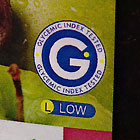Over the next few months shoppers will notice that many food labels are carrying a new symbol. The symbol is for glycaemic index, usually called the GI. Rosemary Stanton explained how the new ‘G’ logo on food labels works.
New symbol
To be eligible to use the G symbol, foods must contain at least 10g of carbohydrate per serving, provide a source of fibre in food groups like bread, cereals and baked products, be low in saturated fat, and not exceed a moderate sodium level. Once companies meet these criteria they’ll pay to use the G symbol, much like the Heart Foundation tick.
What is GI?
The GI rates carbohydrates in foods according to how fast the carbohydrate in the food is digested and converted to blood sugar, compared with eating the same quantity of straight glucose. Carbohydrates in foods with a low GI are digested slowly and don’t cause the sudden rise in blood sugar that you get from higher GI foods.
High GI foods
If you’ve been exercising energetically, a high GI food will help you recover fast. This is important for athletes who train regularly. Eating high GI foods within 30 minutes of finishing strenuous exercise helps restore glycogen supplies in muscles and allows for another full training session the following day. High GI foods include cornflakes, watermelon, sports drinks, glucose-based drinks and lollies, brown or white rice, potatoes, white bread, rice crackers and rice bubbles.
Low GI foods
For most people, low GI foods are preferable because they don’t increase blood glucose rapidly and don’t force the body to produce lots of insulin. Elevated blood glucose levels can lead to type 2 diabetes. Some researchers also think low GI foods could help with weight loss, as high insulin levels reduce the amount of fat the body uses. Low GI foods include beans (fresh and canned), pasta, oats, muesli, barley, wholegrain foods, breads with wholegrain ‘bits’, sourdough breads, peas, sweet corn, apples, oranges, pears, dried apricots and other temperate climate fruits and their juices, nuts and seeds.
Using the GI
The best way to use the GI is to make good choices within a food category. So with cereals, choose rolled oats or muesli rather than cornflakes or ricebubbles. With rice, choose basmati rather than regular white rice. Rather than choosing refined breads, go for wholegrain loaves or old fashioned slow rising bread such as a genuine sourdough. There is no reason to avoid a food just because it has a high GI. Many potato varieties have high GI, but eating potato at the same meal as low GI peas and sweet corn gives an intermediate effect.
Often, the GI concept is misused. Some authors of diet books, particularly those that praise protein and damn carbohydrates, place foods in the wrong GI categories. If you’re going to use the GI, Rosemary recommends that you get your information from reliable sources, such as Diabetes Australia, phone 1300 136 588 or web: www.diabetesaustralia.com.au
GI is an important addition to our knowledge about food and digestion, but it is only one factor and there may be aspects of the concept that need fine tuning. As always, it’s important to choose a range of healthy foods in your daily diet, with GI being just one of the factors affecting that choice. Don’t use GI as an excuse to eat junk foods.



